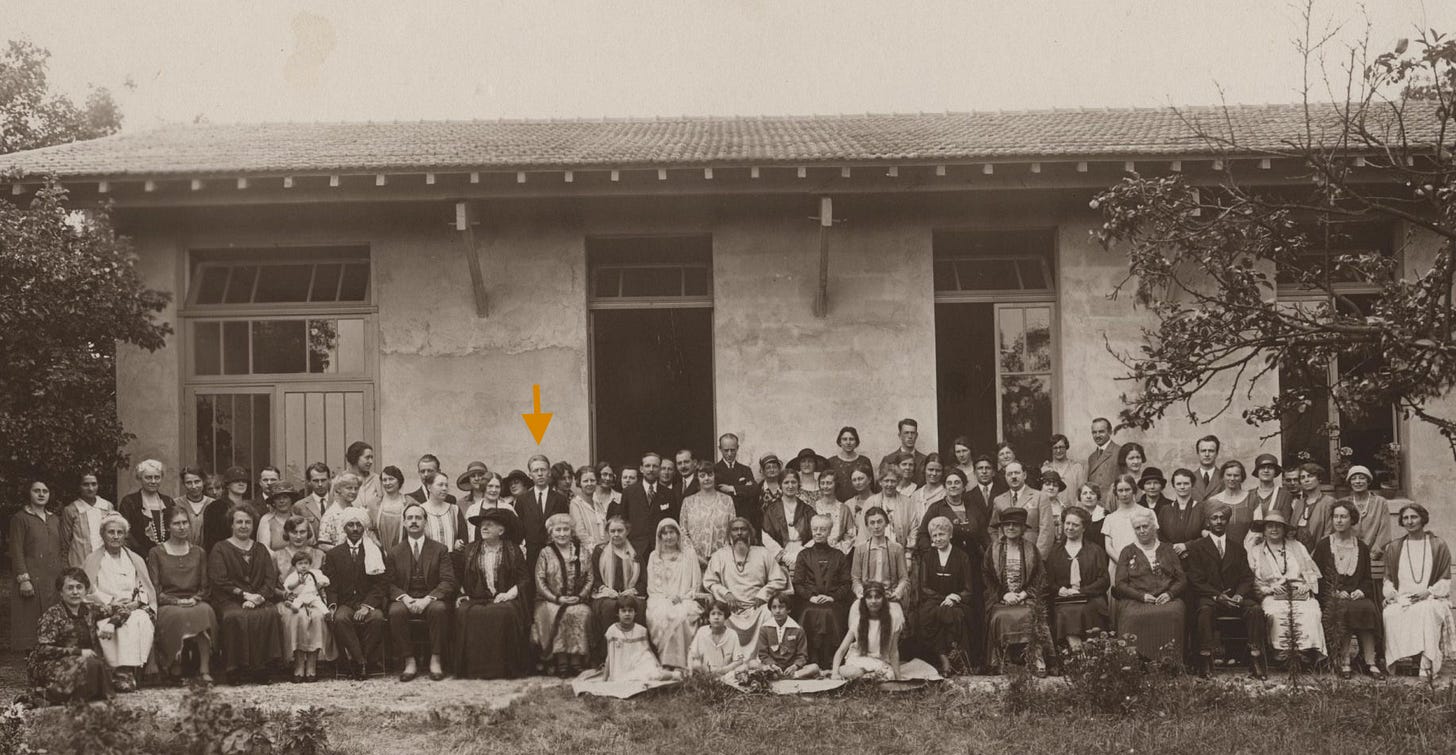Welcome! And a special hello to new subscribers - how good to find you here!
Today’s issue is short, beginning with early photos, and stories you may have read before but which bear repeating. Photos of Summer School are from the Nekbakht Foundation and the comments by Shamcher were part of his biographical information. This section is followed by a short piece from “Fairy Tales are True”.
The Shamcher Bulletin brings you snippets from Shamcher’s writings that might help frame and context our experience of the world we live in today.
Shamcher said: “Once, in the middle of the first Summer School in Paris, I suggested to Inayat Khan that perhaps I was not really fit for this life. He reassured me smilingly that I was, and protected me against assaults by other mureeds, in very subtle ways.”

Celebrating Viladat Day, the birthday of Inayat Khan, all the Sufi pupils and family pose for a group photograph at Summer School in Suresnes. It looks like it was taken in front of the Lecture Hall.
Here’s a closer look at Shamcher, standing young and tall behind some dedicated older Sufi ladies, near the family with the children sitting on the lawn before their parents. Click directly on the image for a larger view.

Murshida Green had asked us “What does Murshid mean to you?”
“Well,” said I, “a friend, an example.”
“Oh you don’t understand at all. Murshid is so much more than all that.”
That same evening Murshid gave a talk but before he started he looked thoughtful, then said: “Before I start my talk I want to mention that sometimes a teacher’s best friends become his worst enemies – by lifting him up onto a pedestal and making of him an inhuman monster instead of what he is and wants to be: Just a friend, an example …”
In September 1926 I saw Inayat for the last time. I said: “I look forward to seeing you next summer.” “From now on,” he replied, “you will meet me in your intuition.” Then, during the first days of February 1927 I had a strange urge to travel to Suresnes, a three-four day trip by boat and rail from Norway. When I arrived others had had the same urge. Early on fifth February came the answer to why we had come. Now the Message was with us.
The Tale of Irma Clark
Irma lived in the dunes with her three children. This was remarkable in itself because the dunes were a man’s world. Occasionally, a woman lived there for a while, but Irma was the only mother with children ever to inhabit the dunes.
The dunes I speak of lie between Santa Maria River and Oceano, “the little town on the Pacific.” Irma lived in a driftwood shack which had been built years ago by moonshiners.
Each morning, Irma took the children to school in a jeep which she kept hidden among the dunes. One morning when she and the children approached the jeep, two strange men were trying to wire the ignition to start it. Without hesitation, Irma whipped out the pistol she carried and fired at them. The bullet lifted one of the men’s hats and they scurried off into the dunes. When she parked the jeep that night, Irma left a sign on it which said, “The next time, my aim will be two inches lower.” Predictably, she had no more trouble.
This part of the story has no great importance except to establish that Irma Clark was not a flimsy mystical sort of woman.
When Irma returned from her morning trip to the school, she swept the sand out of the shack, washed the dishes and chopped wood from the knotty, crooked bushes. Then she went down to the beach for clams.
While she worked, Irma sang. The words were strange and sung with a weird, monumental rhythm, like mountain storms followed by sunshine. I was intrigued by the songs and asked her what language she was singing. She laughed and told me that she had no idea and that she knew no language but English.
I made notes on the songs, catching the sounds on paper as best I could, and eventually brought my notes to the Far Eastern section of the University of California where scholars looked them over. Similarities to Tibetan dialects existed, but the words, as sung by Irma, still made no sense.
Finally, the notes were sent on to a scholar in Lhasa who was a student of ancient Tibetan dialects. After a while, the Tibetan scholar wrote back that Irma’s songs were perfect renditions of a long-dead Tibetan dialect.
(From Fairy Tales are True)

Thanks to everyone who contributed to the comments in our last issue: Shall We Dance? If you missed it, please go in anytime and say Hello! Link through the photo below.
Thanks for responding, sharing, and subscribing to these excerpts from the writings and archives of Shamcher Bryn Beorse.
Feel free to reply to this email if you have Shamcher stories, photos or correspondence to share.
The Shamcher Bulletin is edited by Carol Sill, whose newsletter, “Personal Papers”, is HERE.
If you like this post, please click the heart. And your comments are always welcome.





One note on the Tale of Irma Clark - this is a true story. Her real name was Dixie Paul.
Thanks Carol. Great photo too 🙂